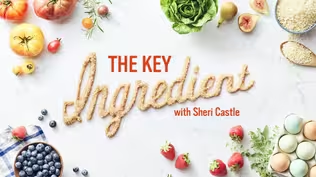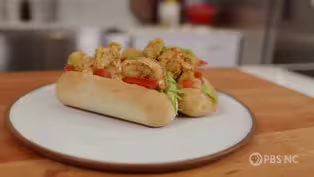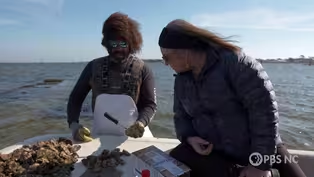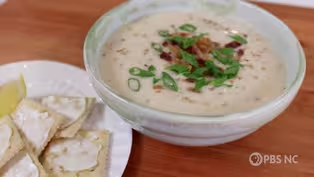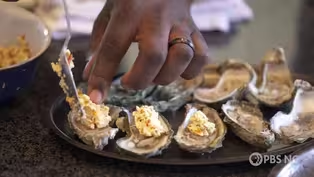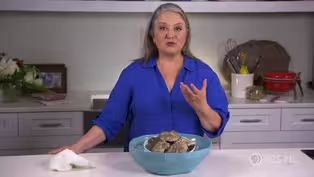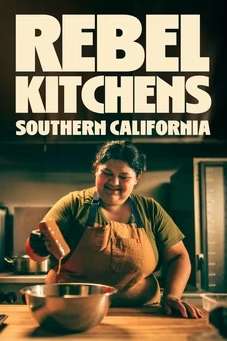
Oysters at Home
9/11/2023 | 26m 29sVideo has Closed Captions
Learn how to be an oyster expert as Sheri cooks recipes from stew to fried oyster rolls.
Sheri explores preparing and cooking oysters with her favorite recipes where anyone can be an oyster expert. From oyster stew with toasted benne seeds to mouthwatering fried oyster, these recipes are soon to be favorites. Sheri delivers helpful hints on safely storing oysters and tours an oyster farm to see how fresh oysters go sea to table.
Problems playing video? | Closed Captioning Feedback
Problems playing video? | Closed Captioning Feedback
The Key Ingredient is presented by your local public television station.

Oysters at Home
9/11/2023 | 26m 29sVideo has Closed Captions
Sheri explores preparing and cooking oysters with her favorite recipes where anyone can be an oyster expert. From oyster stew with toasted benne seeds to mouthwatering fried oyster, these recipes are soon to be favorites. Sheri delivers helpful hints on safely storing oysters and tours an oyster farm to see how fresh oysters go sea to table.
Problems playing video? | Closed Captioning Feedback
How to Watch The Key Ingredient
The Key Ingredient is available to stream on pbs.org and the free PBS App, available on iPhone, Apple TV, Android TV, Android smartphones, Amazon Fire TV, Amazon Fire Tablet, Roku, Samsung Smart TV, and Vizio.
Providing Support for PBS.org
Learn Moreabout PBS online sponsorship[upbeat, plucky music] - [Sheri] Oysters.
There's delicious bounty inside those gnarly shells.
Most people enjoy oysters only at a restaurant, or on vacation, but today, I'm going to convince you that they can be the key ingredient in delightful ways.
A marvelous oyster stew is on our menu, complete with toasted benne seeds.
And don't miss this mouthwatering and impressive crispy oyster roll that is always everyone's favorite.
We set out to sea for a visit with oyster farmer, Ryan Bethea, and watch how he farms oysters and gets them to market.
- And these are animals.
They're gonna grow at different speeds.
- [Sheri] And later, Chef Jamie Davis shows us an oh-so-fancy way to prepare raw oysters at home.
- I think every time we have a get-together, it's gonna be a oyster or some type of seafood.
- [Sheri] Every little oyster is like your own little ocean.
I'm Sheri Castle.
I write cookbooks, I write for food magazines, I cook, I teach, and I collect stories.
And my favorite stories are the ones behind our best loved home recipes.
Is it time to shuck 'em?
- [Ryan] It's time to shuck 'em.
Cheers.
- [Sheri] Oh, that's awesome.
I will go out and explore from the ground up the best ingredients that go into some of our most beloved family recipes.
It's all about the food, the flavors, and finding the key ingredient.
[upbeat music] There's a lot of work that goes into getting oysters from the sea to your table.
We head to beautiful Harkers Island to meet a man who's on a mission to make sure everyone has delicious, fresh, and affordable oysters.
- My name is Ryan Stelter Bethea.
We're on the north side of the island in a place called Westmouth Bay, and we are fortunate enough to have a five and a quarter acre oyster farm.
And so, uh, that's what I do.
I'm an oyster farmer and a business owner.
[rhythmic music] - I am so excited!
How are you?
- Hey, Sheri!
- It's so good to see you!
- Great to see you, too!
Thanks for coming out.
- Oh my goodness.
It's time to go to the water.
You know, this is foreign territory for me.
I'm so excited.
- We're glad to have you.
- I know, what a great day.
What a great day.
- Beautiful.
- Yep.
Alright, step one.
Let's see if we can get me in the boat.
- Alright, this should be pretty easy.
- Alright.
Okay.
I'm in the boat.
- Complete.
We're good to go.
[rhythmic music] - [Sheri] When did you fall in love with oysters?
- Um, you know, I had my first oysters somewhat late in life.
I was about 22, 23 years old down in Destin, Florida, and, uh, you know, I was traveling around bartending all across the country, and, uh, I got some good old Apalachicola oysters.
They were delicious, and I was hooked from there.
[rhythmic music] - So, from when you put in seed oysters to when you start harvesting how long does that take?
- Uh, it, you know, it varies.
We, you know, we gotta remember that we're gonna be putting, you know, we're a small to medium farm, and we're still gonna put 250,000-300,000 oysters out here.
And these are animals, so, you know, they're gonna grow at different speeds.
So, the way I like to tell people is it's kind of like a bell curve.
So, the first 20%, they might grow within 10-12 months, okay?
Then the majority, so 60%, are gonna be that 12-18 month time period, and then the slow growers at the end, the last 20%, are about 18 to 2 years, 18 months to 2 years.
So what you would do is, you know, these cages are right here.
Give it a little shake.
- Look at that.
- Lift it up.
There you go.
Some beautiful oysters right there.
[upbeat, punchy music] And here's our oysters.
- [Sheri] Those are beautiful!
They're, you're right, they're so insanely clean!
- Right?
We've had a really healthy, wild season this year, so we've got lots of little tiny baby oysters.
These are the scars from them, 'cause we had to pull them off, but you can see there's baby oysters all over these.
- And when you said you had to pull 'em off, is that so that they will go be their own oyster because it's, what do you pull 'em off?
- Uh, we just pull 'em off because it's unsightly.
- Gotcha.
- Um, you know, people don't want an oyster, here's a good picture of one.
So that's what an oyster's gonna look like if you just let it, let those little babies grow.
- Isn't, it's like a cluster on them.
- It's like a cluster, which is what people are used to eating most of the time, you know?
- So to get those off, [inaudible] I've just never heard this.
Do, do you have, can you flip them off with your thumb?
Do you pry 'em off with a screwdriver?
- So, so what we do, we do everything by hand on our farm.
So we actually put 'em in a bag, like this, and we're just gonna shake 'em.
Really hard.
- [Sheri] Percussive maintenance.
[chuckles] - Percussive-made is exactly right.
Um, and that's gonna, you know, do a pretty good job of knocking that stuff off, still kinda keeping our, you know, our goal of doing everything out here by hand.
- [Sheri] So is it time to shuck 'em?
- That sounds good.
I'll shuck 'em, you eat 'em.
- Oh boy, now that's a deal.
- Alright.
So, the best way, I can tell, to shuck is you're gonna put the knife at the end of the oyster, and if you can get the knife to stand up on its own, you're pretty much already there, okay?
- Really?
That's a great tip.
- Isn't it great?
It's super easy, anybody can do it.
I know a lot of people get intimidated by shucking oysters, but anybody can do it, especially with a little practice.
So once the knife is like this, you're gonna push and turn at the same time.
There you go.
You're gonna slide it down, you're gonna cut the adductor muscle.
Boom.
There you go.
- Ooh, look at that.
It's so, oh that's a beautiful one.
- It's a gorgeous oyster.
It's a gorgeous oyster.
Nice and fresh, just pulled it out of the water.
I'm gonna cut this adductor muscle for you.
And there you go.
- Alright, I don't want anything on this one.
I want this to be... Good Lord, that's salty.
That is amazing.
- It's very salty.
- That is amazing.
But I do think I should compare for one more.
At least one more.
Make sure that wasn't a fluke.
- Let's do it.
- Okay.
[upbeat, punchy music] - Cheers to North Carolina.
- Amen.
[smooth, rhythmic music] An oyster stew is really more like a oyster soup, and most recipes are nothing more than hot milk and good oysters and maybe a pat of butter.
But some of the original oyster stew recipes include something called benne seed, which is an heirloom form of sesame seeds.
It adds an amazing depth of flavor.
From start to finish, less than 20 minutes.
[rhythmic, relaxed music] So I started by cooking some good quality bacon until it was crisp, and I've removed it from the pot, but I've left that delicious bacon fat in here, and that's gonna be the base to start sautéing my ingredients.
I have 2 bunches of scallions, and I've chopped up the whites, and I'm gonna save the greens to use as a garnish in the end.
Whenever you add onions to a pot to start cooking, always add a pinch of salt.
That little bit of salt will encourage them to turn tender and get done a little bit more quickly.
The next thing is some flour.
I love to use rice flour in this recipe, but regular all-purpose flour is gonna work just fine, as well.
And then stir to coat the flour with some of that delicious bacon fat.
When you add flour to a recipe like this, it takes 2 full minutes to cook out the raw taste from the flour to give you a nice, smooth sauce when you're done.
Now it's time to add some liquid.
I have taken a pint of freshly shucked oysters, and I'm straining them so that their liquid can drain away.
That liquid is called oyster liquor, and there's not gonna be enough liquid from the oysters alone to go in the soup, so I'm gonna add a little bit more liquid.
You have choices.
You can use a really high quality bottled clam juice, chicken stock, a seafood stock, whatever you have.
So, drain your oysters into a measuring cup so you can see how much you have, and then add enough additional liquid to total about two and a half cups.
There we go.
So slowly add your liquid to your sizzling flour mixture.
And then, we're just gonna stir until this turns smooth and gets thick and bubbly.
[upbeat music] So once this starts to bubble, you can tell that it's good and thick.
It looks a little bit like gravy.
And then it is time to add our benne seeds.
Now, benne seeds are an original form of sesame seeds.
And although you can buy them, it's much easier to find high quality, unhulled sesame seeds, and I toasted these in the oven 'till they smelled like sesame oil.
Their fragrance will let you know when they're perfectly toasted.
And then we're gonna add a little bit of cream.
Now once you've added the cream, make sure you lower your heat because we don't want this stew to bubble anymore.
We wanna have a nice wisp of steam coming off of it, but we don't want it to boil.
Now, the benne seeds may have plenty of flavor on their own, but sometimes we need a little bit more of that sesame flavor, and the easiest way to get that is with toasted sesame oil.
Now, toasted sesame oil is delicious, but it's robustly flavored, so start with just a little bit, just a few drops, and then taste your soup until it's just as richly flavored with sesame as you like it.
I got lucky on the first try.
That's great.
And now we're gonna add a little bit of hot sauce.
This isn't to make it spicy, so much as it is to lift the flavors.
And your stew is almost done.
The very last thing you put in are the oysters themselves.
Now, these are raw oysters.
They've been shucked, but they're raw, but they cook in only about a minute.
How long your oysters are going to take depends on their size, but almost no oysters are gonna take longer than two minutes.
You really want them to just warm up.
That's about all that they need.
The way you know an oyster is ready is when the edges just begin to curl a little bit.
And while those oysters are warming up, I'm gonna add a little bit of fresh lemon juice.
You could put a little in the pot.
You might want to also save a little bit to put in each bowl when you're serving it.
I like a big pinch of pepper in my oyster stew.
Anything that has a beautiful creamy base like this loves a good pinch of pepper.
Check an oyster.
Oh, this is perfect.
The edges have just begin to ruffle and curl a little bit.
They're plump and juicy and warmed through, and just like that, this stew is ready to serve.
[light, plucky music] So now there's this wonderful brimming bowl of warm, freshly made oyster stew, and it's time for a few garnishes.
I often add just a few more benne seeds because their toasted flavor is so good in this.
And then that bacon I cooked in the beginning to get those delicious drippings?
It's time for it to go back into the bowl.
And then, our greens that we saved from the scallions?
That's the perfect little bit of green to go on top.
Now, I love to eat oyster stew with buttered saltine crackers.
I know those cute, little oyster crackers might be more traditional, but what I really like is this amazing stew.
There's no doubt that it's an oyster stew, but those benne seeds, those sesame seeds, that makes this extra special.
And it's fast, too.
[plucky music] For many, preparing oysters can be intimidating, and eating them raw, a little daunting.
But there are some secrets to oyster-shucking success with my friend, Chef Jamie Davis.
- [Jamie] These are handpicked, wild-harvest oysters.
- He's making a compound butter sauce that dresses up raw oysters in a snazzy way.
[punchy music] So here we are, on the banks of the Tar River.
Thank you for inviting me over today, and you're gonna help me understand fresh oysters a little bit.
And, who's this fine person you brought with you?
- One of my lead line cooks, Jaquan Moore.
- [Sheri] So tell me about your history.
Did you grow up eating them?
- [Jamie] We grew up eating oysters right off the beach.
- [Sheri] Amazing.
So you'd go out and do... - No, we'll go to the seafood market, but you can tell they came straight from the ocean.
Super salty, super briny, and that's the way I like 'em.
- [Sheri] Oh, that's what I think, too.
I always think that every little oyster is like your own little ocean.
Little bit of ocean in each shell.
- [Jamie] Yes, yes most definitely.
- Alright, so I'm ready for my lesson.
Like I said, I've tried this, and it's just not a skill I own.
Like a sports move, it's not in my playbook yet.
So, I'm gonna watch you do a couple, then I'm gonna see if I'm brave enough to try.
- Awesome, by the end of the day, you'll have it, trust me.
- Okay.
- Alright, super simple.
Your favorite shucker to always have.
- Okay, and you've got an actual shucking knife.
You said that your mama's people used to use a screwdriver, but this is better because of a thin blade, right?
- I haven't perfected a screwdriver, yet, so I go what I know.
- Oh, yes, okay.
- Get you a nice towel, and you wanna cover it.
So if you cover it, if you slip, you'll hit the towel instead of your hand.
- Now, that's, that's a good tip.
Or it'll suck up the blood.
I shouldn't say that, nevermind.
- Well, it took me a couple stabs in the hand to realize I need the towel there.
- [Sheri] And you're going into that little slot that we're looking at, okay.
- And you just twist.
Then I like to wipe it off so you don't get anything dirty.
- [Sheri] And so you're, okay, alright.
- [Jamie] Slide all the way through.
- Well, look at that.
I love how easy an expert makes anything look.
And you're just gonna loosen it up a little bit.
- [Jamie] Loosen it up, and there you go.
- Mhm.
Alright, show me another one, and then I think I'm gonna try this.
- So, same, same.
Got your little notch, towel same exact spot, go in, uh-oh, sometimes that happens.
- That's alright.
I need to see all possible outcomes.
- [Jamie] There you go.
- [Sheri] Now, what kind of oysters are these?
Do you know?
- [Jamie] These are handpicked wild-harvest oysters right outside of the Masonboro Sound.
- And I just think that, you know, that one of the tricks to buying any kind of fresh seafood, shellfish, is buy from somebody you trust, somebody that can answer your questions, and then let them guide you to what the pick of the day is.
- Yes, pretty much, pretty much.
If you don't trust your people you get seafood from, then maybe you shouldn't get it.
- Yeah, that's good advice, isn't it?
Okay, let's fetch one out the sack and we'll see what I can do.
- [Jamie] There you go, take a step back.
- Yeah, back up.
That's a good idea.
- Just a little twist.
There you go.
- Oh my goodness, look at that!
- Easier than what you thought it was.
- Uh-huh, now I'm gonna bring my, this, this direction?
To finish taking it off.
- And you just wanna slide it.
- I'm spilling my oyster liquor here.
It's not, it's, It's like a three point turn, it's a seventeen point turn for me.
- Alright, well don't touch, there you go.
- Alright.
Then we're gonna loosen it up.
- Mhm.
Perfect.
Next party, you're gonna be shucking.
- Alright, so we filled up our tray, and this is just a little heatproof thing, so anything that'll go in the oven is gonna work, this little sizzle tray.
So now, do you put the, do you put the butter on and then in the oven?
- [Jamie] Put the butter on first, and you just want it to melt all over, trust me.
- Alright, let me watch this.
- It's gonna be beautiful.
- You can tell that butter's gonna be good.
I know it's not pimento cheese, but it's got so many peppers, it's got that beautiful color already.
And I love that it's just the butter, you know?
It's not an overly complicated, this is an Oysters Rockefeller, it's just... - [Jamie] Compound butter with some herbs and things, and freshness, I don't think you can beat it.
- You got a pretty generous dollop there.
That's like a teaspoon, okay.
And you can clearly make that butter ahead, 'cause it holds really well.
- Yes ma'am.
There you go.
Perfect.
- Alright.
And then how hot's the oven?
- [Jamie] Alright, this oven right here is 425.
[upbeat music] - [Sheri] So, how much do you have to let them cool off before it won't burn your whistle?
- I think we can go.
I think we can go.
- Alright.
Alright.
I'm going to do this one.
We're going, let's do this together.
- I'm just gonna go for it.
- Alright.
I'm not gonna, it's like, you know, we're not using chopsticks.
By golly, they're, I'm putting my fork down.
- [Jamie] I'm just tight to go.
- Alright, oh yeah.
Cheers, my friends.
[drum roll] Holy moly.
You know, not only is that, do more for the oyster, that little bit of warmth really brings out that butter.
That's an all-around experience.
My gracious, that's delicious.
- [Jamie] It's delicious.
- I don't know why anybody would ever sit down, they should just stand as close as they can get.
- Just stand up.
That's it.
- One of my favorite ways to prepare oysters at home is in a quick sandwich known as an oyster roll.
You tuck crispy freshly fried oysters in a good bun.
It is quicker than making burgers.
It is so delicious, and I'm gonna show you how to do it.
[upbeat music] I top my oyster rolls with a sauce, and I gotta tell you, I probably have never made it the same way twice, but I usually start with some mayonnaise for a little bit of creaminess.
And then I add something tomato-y.
It can be ketchup if I want it mild, it could even be a spicy cocktail sauce if that's what you have.
Just enough to balance out the mayonnaise.
And then I get more creative.
I usually put in a good pinch of garlic powder, maybe a good pinch of onion powder, couple drops of hot sauce.
Now that can be a couple drops or a really good glug depending on what you like.
A couple of drops of Worcestershire sauce, and a good squirt of lemon.
Then stir that up, give it a taste, and then continuing doctoring and playing with it until it suits you.
And there you have it.
There's our sauce.
Now, let's get to frying some oysters.
So we're gonna deep-fry these oysters.
Now, don't worry.
Deep-frying at home is actually very simple.
All you need is a good, deep pot, some peanut oil, and a thermometer.
I promise, that's it.
Breading the oysters is almost as simple.
There are lots of recipes for oyster breading, but time after time, I turn to a product called fish fry.
Yes, that's what it's gonna say on the back, "fish fry."
It's a cornmeal product that comes already seasoned and ready to go.
All you have to do is pour it on a plate.
And I'm also starting with shucked oysters.
Some people put a batter on their oysters, but I think they taste more like an oyster if you skip the batter, and instead just put the breading directly on them.
I like to do a few oysters at a time.
about the number I intend to fry, so maybe a half dozen, and work in batches so that my cornmeal mixture, my fish fry, doesn't get clumpy and lumpy as I work.
[light, rhythmic music] While I'm doing this, I'm letting my oil get hot.
One of the secrets, maybe the secret, to deep fat frying is to make sure the oil is at the right temperature.
So I had heated this peanut oil up to about 365 degrees.
There's a window for oysters of about 365 to 375, and each time you add more oysters, give your oil a little bit of time to come back up to temperature so that they'll turn out really crisp.
Add just a few oysters at a time.
You wanna make sure they can float freely in the oil.
Oysters cook quickly.
Small ones are done in only one minute, but even the large ones are gonna be done in two.
[oil sizzles] And that's it.
In less than a minute, you have these perfectly crispy, gorgeous oysters.
Now, I like to, while they're warm, hit 'em with just a tiny bit more salt.
So now let's build some oyster rolls.
I like to use little sandwich buns and hollow out the middle, but you can use a hot dog bun or any kind of bun you have.
I usually put a little bit of our delicious sauce in the bottom, and then I'm gonna add some crisp lettuce.
"Crisp" is key here.
If there's ever a time to use good ol' Iceberg, it's this.
Just a little bit of lettuce.
If you like it, you can tuck in a little tomato, but you wanna make sure that there's room for a whole row of these amazing oysters.
Really tuck 'em in there.
It's hard to say if this is sandwich or knife-and-fork food, or maybe a little bit of both.
You know what?
I'm gonna use my fingers.
Really pile 'em in there.
Now, if you don't wanna make the oyster rolls, or maybe you have a few left over, it is delicious to just stand and eat them dipping them in the sauce.
These are also fantastic on top of a Caesar salad.
Last but not least, the crowning touch is another drizzle of our amazing sauce.
[light European music] I can't wait any longer, I have to give one of these a try while they're still good, hot, and crispy.
I'm gonna dip 'em right in the sauce.
You know, you could have people over and just give 'em this, and they will speak well of you for at least 6 months.
This is delicious.
[upbeat music] ♪ It's ready ♪ ♪ Yes it's ready ♪ ♪ So just let it all begin ♪ [bright, airy music] Once you bring your oysters home from a trusted source, this is how you can store them safely for a few more days.
Oysters like to be cool, airy, and damp.
To keep them cool, put 'em in the coldest part of your refrigerator.
To keep them airy, if they're in a mesh bag, leave them in that bag.
But if you've purchased them loose like this, just stack 'em in a bowl where air can circulate around.
They're happy in the fridge, but if you have to take them out of the fridge for any reason, sit them on a bowl of ice.
Not directly on the ice, but lifted up out of that a little bit.
The last thing is to keep them damp.
I like to do that by wringing out a lightweight kitchen towel and just draping it over the top and checking it every morning to make sure that it is still damp.
Now, stored safely and properly, oysters are gonna keep for several days, but when it comes to fresh oysters, sooner is always better.
[bright, relaxed music] Oysters don't have to be cumbersome or mysterious.
They are a bounty of the sea full of flavor and texture that can serve as the key ingredient to delight everyone.
Not just on special occasions, but any meal when we say, "It's oyster time."
Correct me on this, because like I said, I didn't grow up in the land of oysters.
That was always, you know, came in one time a year.
But, can you taste the differences in different varieties?
I've always thought I could, but I'm not sure if I'm not making that up.
Each oyster has a taste.
- Yeah, everything is totally different.
These right here, I love 'em, but if you get some from, say, Maine area, they're a little more brinier.
If you get 'em from the West Coast, I feel they have a little bit more a metallic flavor.
But I grew up, again, with the briny saltiness straight from the ocean.
Tastes just like when you jump in the ocean and you get a mouthful of saltwater.
I feel like that's what I look for when I grab a oyster.
[triumphant music] - [Sheri] For all the recipes from the show, visit our website.
It's where you'll find the key ingredient for a perfect time in the kitchen.
Crispy Oyster Rolls | Kitchen Recipe
Video has Closed Captions
Clip: 9/30/2021 | 5m 13s | Sheri fries up some crispy oyster rolls with both spicy and mild tartar sauces. (5m 13s)
Oysters: From the Sea to Your Table
Video has Closed Captions
Clip: 9/30/2021 | 5m 55s | Oyster farmer Ryan Bethea gives Sheri a tour of his operation on Harker's Island. (5m 55s)
Oyster Stew with Toasted Benne Seeds | Kitchen Recipe
Video has Closed Captions
Clip: 9/30/2021 | 5m 54s | Sheri creates a filling, hearty oyster stew with toasted benne seeds. (5m 54s)
Roasted Oysters | Cook Along with Jamie Davis
Video has Closed Captions
Clip: 9/30/2021 | 5m 4s | Chef Jamie Davis & Sheri shuck and roast fresh oysters with delicious, spiced butter. (5m 4s)
Sheri Says: Safely Storing Fresh Oysters
Video has Closed Captions
Clip: 9/30/2021 | 1m 1s | Sheri demonstrates the three keys to keeping fresh oysters in your home before cooking. (1m 1s)
Providing Support for PBS.org
Learn Moreabout PBS online sponsorshipSupport for PBS provided by:
The Key Ingredient is presented by your local public television station.
